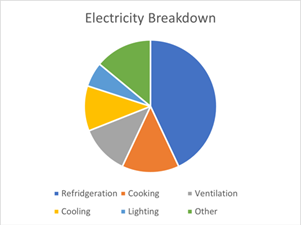With the impact of loadshedding increasing month by month there is one industry that is battling to maintain their quality of production and service. The food hospitality industry relies on uninterrupted electricity to ensure their product maintains up to standard. Sustaining constant refrigeration of food produce is crucial, and load shedding compromises this, resulting in losses from having to dispose of food and increasing the risk of contamination. Because of this, many food establishments need to rely on diesel generators, whose operation is both unsustainable, harmful to the environment, and expensive. Companies are forced to explore alternative methods to sustain their businesses. This article focuses on the main challenges that food establishments encounter as load shedding becomes more frequent and offers some potential mitigation strategies that are available in South Africa.
According to reports by commercial banks, load shedding leads to an increase in the number of people eating out and ordering takeaways[1]. This places additional pressure on establishments to ensure that they can operate smoothly during periods of load shedding. Restaurants depend on a wide variety of equipment that must remain operational throughout their service hours. Most of the energy is consumed by items such as electric ovens, extraction systems and deep fat fryers, which are essential for most restaurants. In 2022, the total hours of load shedding for the year amounted to 3,776, whereas in 2023, we have experienced 2,442 hours of load shedding already through until mid-April[2]. Undoubtedly, this worsening trend is expected to continue in the coming months and years, leading to the question: how are restaurants and food establishments being impacted?

Graph 1: Typical Electricity breakdown of a franchise restaurant. Source – https://www.businessenergy.com/blog/restaurant-energy-efficiency-guide/
- More Frequent Energy Surges
- Energy measurement studies undertaken by NrG at some of the leading food brands in South Africa indicate that when equipment is turned on, there is a surge of electricity, and establishments without uninterrupted power supply are subjected to surges more frequently during load shedding.
- As a result, their energy usage increases, leading to higher bills.
- Damages to Equipment
- Power surges can also cause damage to equipment, reducing their lifespan and resulting in additional maintenance and replacement expenses.
- Loss of Revenue
- Loadshedding can often impact opening hours resulting in less customers and therefore less revenue.
Issues Faced by Food Establishments
Mitigation Strategies
- Regular Maintenance
- Ensure that equipment is regularly checked and scheduled for maintenance. When equipment is kept well and working it is more efficient which results in lower usage, and they are less susceptible to damages from surges.
- Staff Training
- Ensure staff are aware of their energy usage and that they are knowledgeable in ways to reduce their usage. (e.g., Switching all unnecessary lights off, etc.)
- Make sure staff are aware of loadshedding schedule to plan around it to avoid fulfilling tasks/orders.
- Train staff to react to issues formed from loadshedding, as well as knowing backup plans that have been put in place.
Mitigation Strategies (Alternate Energy Solutions)
- Generators: Generators are the most common and readily available option for food establishments. They have low installation costs, but the rapid increase in fuel prices and concerns about carbon emissions have led to consideration of various solar PV options.
- Grid-Connected Solar Systems: Grid-connected solar systems have the lowest installation and system costs, but they are unable to operate during load shedding.
- Solar Systems Coupled with a Generator: This option can operate fully during load shedding while reducing generator fuel consumption, but the dependency on the generator for its availability and grid-forming ability results in similar issues as a generator-only system.
- Solar Systems Coupled with Batteries: This option eliminates fuel costs and carbon emissions and can fully operate during load shedding. However, the costs are high due to battery prices.
- Battery-Only Systems: Battery-only systems can provide energy security during load shedding, but the costs will also be high, and carbon emissions are not reduced because the batteries must charge from the utility grid.
To sum up, load shedding has had a significant impact on the restaurant industry in South Africa. Frequent power outages have led to a decline in revenue and increased costs, as restaurants find it difficult to maintain a consistent level of service. Ultimately, until a long-term solution to the energy crisis is implemented, restaurant owners and managers must remain flexible and adapt to the challenges presented by load shedding to ensure the survival and success of their businesses.

